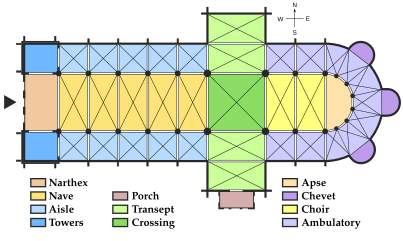|
Latin cross A Latin cross or crux immissa is a type of cross in which the vertical beam sticks above the crossbeam,[1] giving the cross four arms. Typically the two horizontal and upper vertical arm are the same length, although sometimes the vertical is shorter, however the lower vertical arm is always much longer than any other arm.[2] If displayed upside down it is called St. Peter's Cross, because he was executed on this type of cross.[3] When displayed sideways it is called St. Philip's cross for the same reason.[3] Many medieval churches are designed using the Latin cross plan. When looked at from above, it takes the shape of a Latin cross. A Latin cross plan primarily contains a nave, transept, apse, and narthex. History In a broad sense, the Latin cross is used to represent all of Christianity and Christendom, given that it teaches that Jesus sacrificed himself for humanity upon it, atoning for the sins of the world.[4][5] It is especially used among the denominations of Western Christianity, including the Roman Catholic tradition and several Protestant traditions, such as Lutheranism, Moravianism, Anglicanism, Methodism, and Reformed Christianity, as well as by Anabaptists, Baptists, and Pentecostals.[6] In certain periods, such as during the 16th century English Reformation of the Anglican Church, the Latin cross was disfavored by a minority of theologians such as Nicholas Ridley, though in the overall history of the Western Christian Churches, this was short-lived.[7] Cruciform Churches A Latin cross plan is a floor plan found in many Christian churches and cathedrals.[8] When looked at from above or in plan view it takes the shape of a Latin cross (crux immissa).[9] Such cruciform churches were very common in the West during the Romanesque period.[2] The ideal church plan tended to be symmetrical around a central point during the Renaissance.[10] The longer arm of the Latin cross plan is the nave, which runs on an east–west axis and traditionally contains aisles or chapels.[10][11] The transept crosses the nave, running north–south, and can be the same width as the nave, or extend further on both sides to create a more pronounced cross shape. The east end is the apse, which traditionally contains the choir, chancel, or presbytery.[11] Many also have a narthex at the entry.[9] Examples of Cathedrals with a Latin Cross Plan
In computer systemsThe glyph has a unicode code point: U+271D ✝ LATIN CROSS Similar marks
See alsoReferences
|
